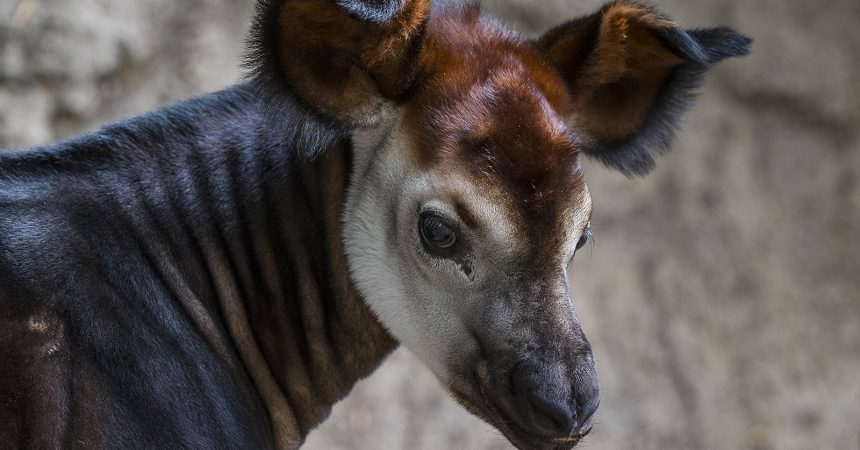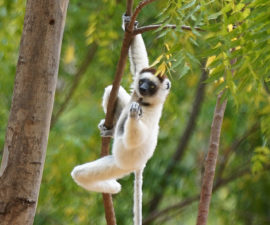The first thing I notice when Dr. Barbara Durrant rushes into the lab are her earrings. A shiny okapi is dangling from each ear. The average person would likely be unaware of the okapi’s existence much less own a pair of earrings depicting their unique appearance. Okapis (an African hoofed species) have distinctive, bold, brown-and-white stripes on their legs and rump for camouflage in the dense jungles of the Democratic Republic of Congo. Dr. Durrant’s earring choice on this day was quite appropriate as she was bringing news that M’Baya, an okapi we had been monitoring for the past 15 months, was finally in labor!
In 2016, two female okapis housed at the San Diego Zoo, Safarani and M’Baya, bred with a newly arrived male named Amare. Safarani was a proven breeder and mother of three while M’Baya had conceived in the past but never carried a pregnancy to term. For both females, measuring the levels of progesterone, the hormone that maintains gestation, was key in monitoring the stability of their pregnancies. The Reproductive Sciences team had documented the erratic progesterone levels in M’Baya’s previous unsuccessful pregnancies and thought M’Baya’s past losses could be due to a lack of placental progesterone (progesterone from the calf). To maintain her progesterone levels, M’Baya was put on a hormonal supplement called Regumate. Progesterone supplementation is used routinely in humans and other species such horses, and our lab had successfully sustained pregnancies in cheetahs, southern white rhinos and greater one-horned rhinos which also exhibited early pregnancy loss, but this was our first attempt to use Regumate for an okapi.
Over the 15-month gestation, keepers collected fecal samples three times a week and sent them to our lab for processing. In the lab I use a machine called a lyopholizer (basically a freeze dryer) to eliminate all water from the feces overnight. The next day the samples are crushed and sifted to remove any large hay and or bedding particles. Then samples are weighed and finally hormones are extracted using a solvent boil that separates hormones from the poo slurry. Luckily for me, okapis mainly eat leaves so their poo is less pungent than feces from other carnivorous species processed in the lab!
After the samples are processed, a tried and true test known as a radioimmunoassay (RIA) is used to determine the amount of hormone in a particular fecal sample. To measure the pregnancy hormone progesterone I use a progesterone-specific antibody with which the progesterone (extracted from the fecal sample) competes for binding against known amounts of radiolabeled progesterone. This battle for binding continues overnight and the following morning I can calculate the amount of progesterone in a given okapi fecal sample. Overall the process takes about three days of lab work, meaning the test is used for monitoring pregnancy rather than as a predictor of birth, since I am always a few days behind the actual reproductive events in the animal.
As M’Baya’s pregnancy progressed past the 5-month mark, the next question was how long to keep her on the hormonal supplement. The decision was made to wean her slowly off of Regumate days before her predicted due date. The date needed to be precise, a calf born too early or too late could bring harm calf and/or mother. As the due date approached, I ran progesterone assays daily on a single sample to make sure values did not drop dramatically along with the decrease in Regumate supplementation. Fortunately, M’Baya was able to maintain pregnancy values of progesterone on her own for a full week after being weaned off Regumate and a healthy male calf, Mosi, was born on July 21, 2017.
Despite their mysterious nature, the okapi has done surprisingly well under proper management in captivity. In fact, the San Diego Zoo and Safari Park have had 72 okapi calves born on grounds since 1962. Successes like these cannot be accomplished alone and can be attributed to dedicated keepers with a strong understanding of okapi behavior, outstanding veterinarian expertise and the science of consistent hormone monitoring performed by our labs. While Dr. Durrant has spent over two decades monitoring okapi hormones and is an expert in okapi reproduction, I still think on that day her earrings may have helped a tiny bit.
Rachel Felton is a research lab technician at the San Diego Zoo Institute for Conservation Research. Read her previous blog, Expanding on a Legacy.





